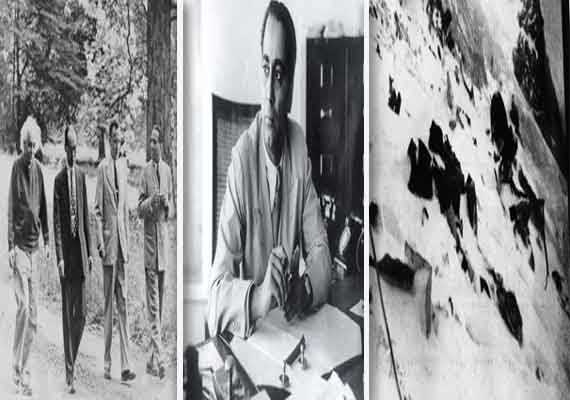
25-Jun-2024 , Updated on 8/19/2025 12:03:36 PM
Was Homi J. Bhabha killed by the CIA?? True?
Today, when we look at India, we see a nation transformed, a country that stands tall among the world's powers. This transformation is due to the countless individuals who sacrificed their lives, serving their country with unwavering dedication. Among these heroes, one name shines brightly: Homi Jehangir Bhabha. Bhabha's vision and relentless pursuit provided India with the capability that even the world's greatest powers respect and avoid challenging. It was not just the dream of a man riding a scooter; it was the dream of nuclear prowess for India.
Homi Bhabha's journey began on a fateful Tuesday when he initiated a program to select research scientists. His efforts are credited with making India a nuclear-capable nation. However, the nation faced a profound loss when Bhabha died in a mysterious plane crash, a tragedy that occurred just days before the unexplained death of India's second Prime Minister, Shri Lal Bahadur Shastri.
Experts have long speculated about the Congress party's involvement in Shastri's mysterious death, hinting at the possible involvement of the CIA and other brutal forces. Stories about Homi Bhabha's life and the circumstances surrounding his death often surface, attempting to shed light on the political conflicts of that time.
Homi Jehangir Bhabha, often referred to as the father of the Indian nuclear program, hailed from a distinguished Parsi family with strong ties to prominent businessmen like Jee Petitcoat and Dorabjee Tata. His family had a tradition of excelling in education and service. Bhabha's grandfather, also named Homi Jehangir Bhabha, served as the Inspector General of Education in Mysore. Bhabha's father, Jehangir, and his mother, Murti Bhabha, were well-educated, and his maternal grandmother was the granddaughter of Din Somvanshi, known for her contributions to Mumbai's fragrance industry.
Homi Bhabha's academic journey took him to Mumbai's Alstom College and then to the University of Cambridge's campus college. In 1931, Bhabha was honored with an engineering award, and in 1933, he published his first significant paper on cosmic radiation. By 1939, Bhabha had earned the title of rocket scientist in nuclear physics. World War II broke out, and Bhabha, then in India, decided to stay back rather than return to England.
During this period, Bhabha accepted an offer to work in the physics department of the Institute of Science, driven by his belief that India needed to become a global power. He convinced his close friend, Pandit Jawaharlal Nehru, that science was the key to India's progress. Bhabha transformed the Cosmic Ray Research Unit into the renowned Tata Institute of Fundamental Research in 1954 and spearheaded research on nuclear weapons.
Under Bhabha's leadership, the Atomic Energy Establishment became a cornerstone of India's nuclear program. Despite his significant contributions, his work in nuclear weapons development often went unacknowledged. Bhabha was appointed Chairman of the Indian Atomic Energy Commission and was honored with the Padma Bhushan. He was even nominated for the Nobel Prize in Physics several times between 1951 and 1956.
Tragically, on a fateful day, Air India Flight 101, a Boeing 707 carrying Homi Bhabha, crashed into Mont Blanc in the Swiss Alps. All 117 passengers, including Bhabha, perished. The official explanation attributed the crash to miscommunication between the airports, but many theories suggest otherwise. Some believe the crash was a well-planned conspiracy involving the CIA aimed at preventing India from becoming a nuclear power.
Lal Bahadur Shastri, who had been concerned about nuclear testing, had hinted that India was capable of developing nuclear weapons. Just days after his death, Homi Bhabha also died under mysterious circumstances. The timing raised many questions. Some believe the CIA orchestrated both deaths to prevent India from advancing its nuclear program.
Former Indian authorities completed the investigation hastily, leading many to suspect a cover-up. Bhabha, determined to make India self-sufficient in nuclear power, had envisioned a future where India could defend itself with nuclear weapons. His dream was realized posthumously when India successfully tested its first atomic bomb on May 18, 1974.
Homi Bhabha's dream did not die with him. His vision for a self-reliant and powerful India lived on. Despite the tragic and mysterious circumstances surrounding his death, Bhabha's contributions to India's nuclear program remain monumental. His life and work continue to inspire, reminding us that dreams, even those cut short, can leave a lasting legacy.
To read more:
1: What was the continution of Homi J. Bhabha in Indian nuclear science
2: Tashkent Files- The Film Which Discover Lal Bahadur Shastri's Death Mystery
3: Putin says we are ready for nuclear war, what's next?

Student
I am a content writter !
Comments
Join Our Newsletter
Subscribe to our newsletter to receive emails about new views posts, releases and updates.
Copyright 2010 - 2025 MindStick Software Pvt. Ltd. All Rights Reserved Privacy Policy | Terms & Conditions | Cookie Policy